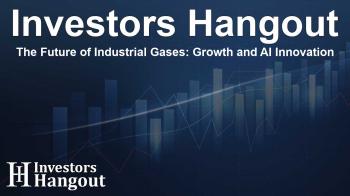The Future of Industrial Gases: Growth and AI Innovation

Growth of the Industrial Gases Market: A Deep Dive
The global industrial gases market is poised for significant expansion, with estimates suggesting an increase of USD 31.1 billion between 2025 and 2029. This growth is fueled by rising demand across various sectors, driven by strategic facility expansions and the transformative power of artificial intelligence (AI).
The Role of AI in Market Transformation
Artificial intelligence is playing a crucial role in revolutionizing the industrial gases landscape. By improving operational efficiencies and predicting demand patterns, AI technologies are enabling companies to optimize their gas production and distribution processes. This shift not only enhances productivity but also leads to cost savings for enterprises operating within competitive markets.
Key Markets Driving Demand
Several industries are significantly contributing to the rising demand for industrial gases. In the chemicals and fertilizers sector, gases such as nitrogen, hydrogen, and oxygen are critical for production processes. The increasing global population and urbanization trends are pushing for greater food production, further amplifying the need for nitrogen-based fertilizers.
Expansion in Semiconductor and Electronics Industries
The semiconductor industry is rapidly evolving, emphasizing the importance of hydrogen and ultra-high purity gases for fabrication processes. AI advancements are facilitating more refined manufacturing techniques, resulting in improved product quality and efficiency. As technology progresses, the requirement for these gases will continue to rise, further propelling market growth.
Market Challenges to Address
Despite the optimistic growth forecasts, the industrial gases market is not without its challenges. Issues related to gas distribution and specialized handling systems are prevalent. Ensuring safety and compliance with stringent regulations is paramount, particularly in sectors like healthcare and food and beverage processing.
Safety Regulations and Industry Standards
Safety in handling industrial gases is non-negotiable. Regulations ensure employee safety and environmental protection. Companies must adhere to stringent standards in distribution channels to prevent contamination and ensure gas quality.
Market Segmentation and Geography
This dynamic market can be segmented based on user end industries, types of gases, and geographic distribution. The primary gases in demand include nitrogen, oxygen, hydrogen, and carbon dioxide, with applications spread across manufacturing, chemicals, metal fabrication, and energy sectors.
Key Geographical Regions
Regions leading in industrial gases consumption include Asia-Pacific, Europe, North America, South America, and the Middle East and Africa. The Asia-Pacific region, in particular, is projected to account for a significant portion of the market, driven by rapid industrialization and increasing infrastructure investments.
Leading Players in the Industrial Gases Field
The competitive landscape features major players such as Linde, Air Liquide, Air Products and Chemicals, and Messer. These companies are actively pursuing mergers and acquisitions to enhance their market presence and improve operational efficiencies.
Recent Developments
Recent announcements by major companies, including a significant investment by Air Products in a regional facility, showcase how leading firms are strategically positioning themselves to meet evolving market demands. Such proactive measures are instrumental in enhancing their competitive edge in a fragmented market.
Conclusion: A Bright Future Ahead
The future of the industrial gases market looks promising, driven by technological advancements and increasing demand from key sectors. With ongoing innovation and strategic expansions, the market is set to thrive, presenting abundant opportunities for growth and development.
Frequently Asked Questions
What is the expected growth of the industrial gases market?
The industrial gases market is expected to grow by USD 31.1 billion from 2025 to 2029, reflecting a robust CAGR of approximately 5.7%.
How is AI impacting the industrial gases sector?
AI is transforming the industrial gases market by optimizing production and distribution processes, thereby enhancing operational efficiency and reducing costs.
What are the key gases driving market demand?
Key gases in demand include nitrogen, hydrogen, oxygen, and carbon dioxide, primarily used in the chemicals, fertilizers, and semiconductor industries.
What safety regulations apply to industrial gases?
Safety regulations are crucial in the industrial gases market to ensure the safe handling, distribution, and usage of gases, protecting both employees and the environment.
Which regions are most significant in the industrial gases market?
Asia-Pacific is the leading region for industrial gases consumption, followed by Europe and North America, driven by rapid industrialization and technological advancements.
About The Author
Contact Dominic Sanders privately here. Or send an email with ATTN: Dominic Sanders as the subject to contact@investorshangout.com.
About Investors Hangout
Investors Hangout is a leading online stock forum for financial discussion and learning, offering a wide range of free tools and resources. It draws in traders of all levels, who exchange market knowledge, investigate trading tactics, and keep an eye on industry developments in real time. Featuring financial articles, stock message boards, quotes, charts, company profiles, and live news updates. Through cooperative learning and a wealth of informational resources, it helps users from novices creating their first portfolios to experts honing their techniques. Join Investors Hangout today: https://investorshangout.com/
The content of this article is based on factual, publicly available information and does not represent legal, financial, or investment advice. Investors Hangout does not offer financial advice, and the author is not a licensed financial advisor. Consult a qualified advisor before making any financial or investment decisions based on this article. This article should not be considered advice to purchase, sell, or hold any securities or other investments. If any of the material provided here is inaccurate, please contact us for corrections.

